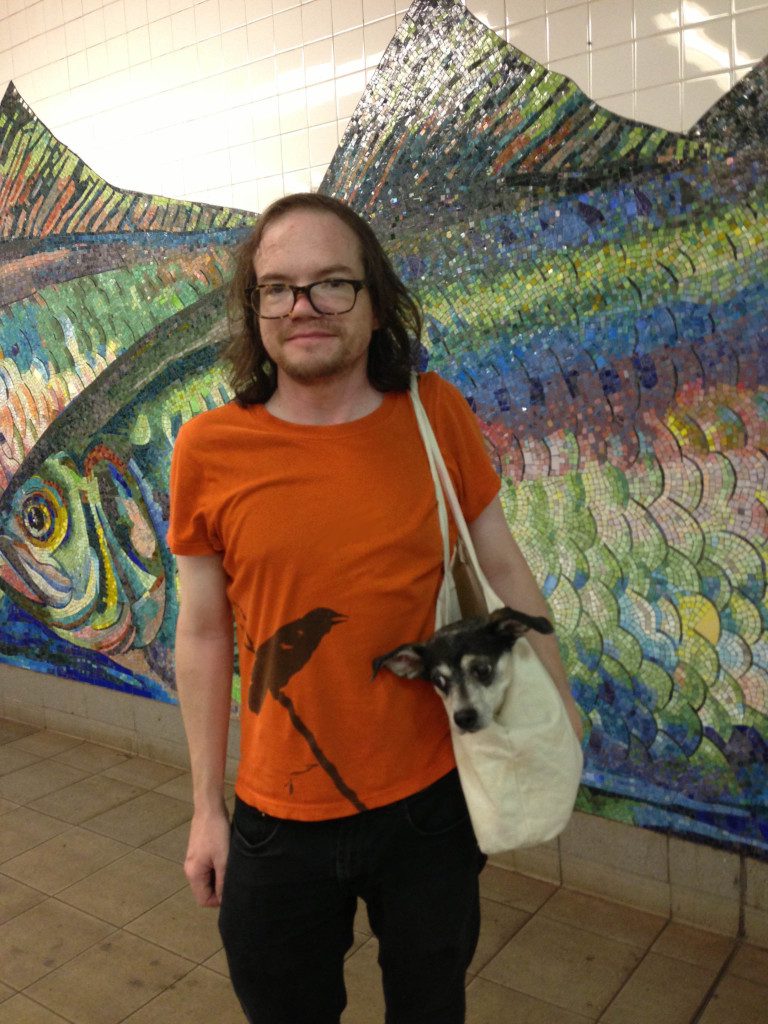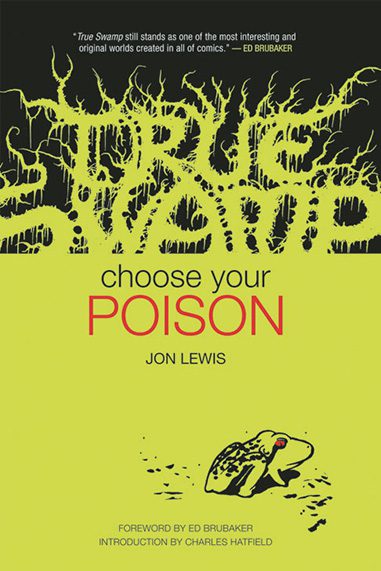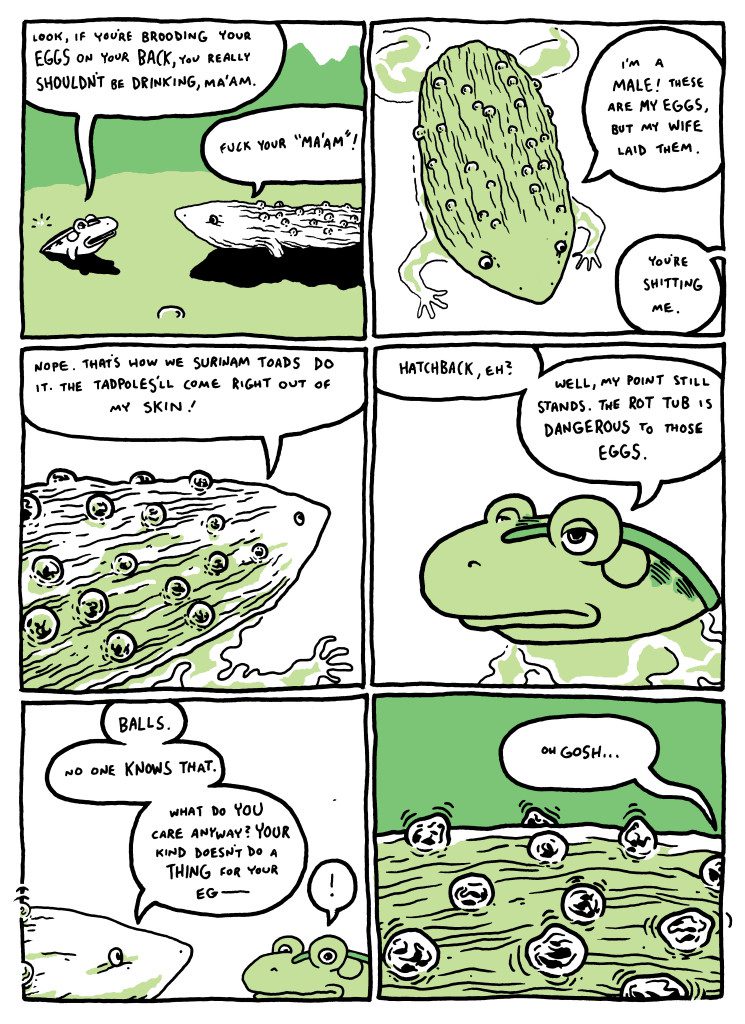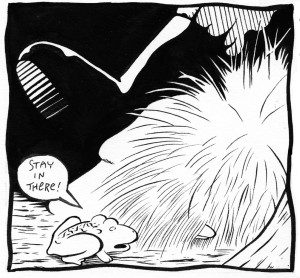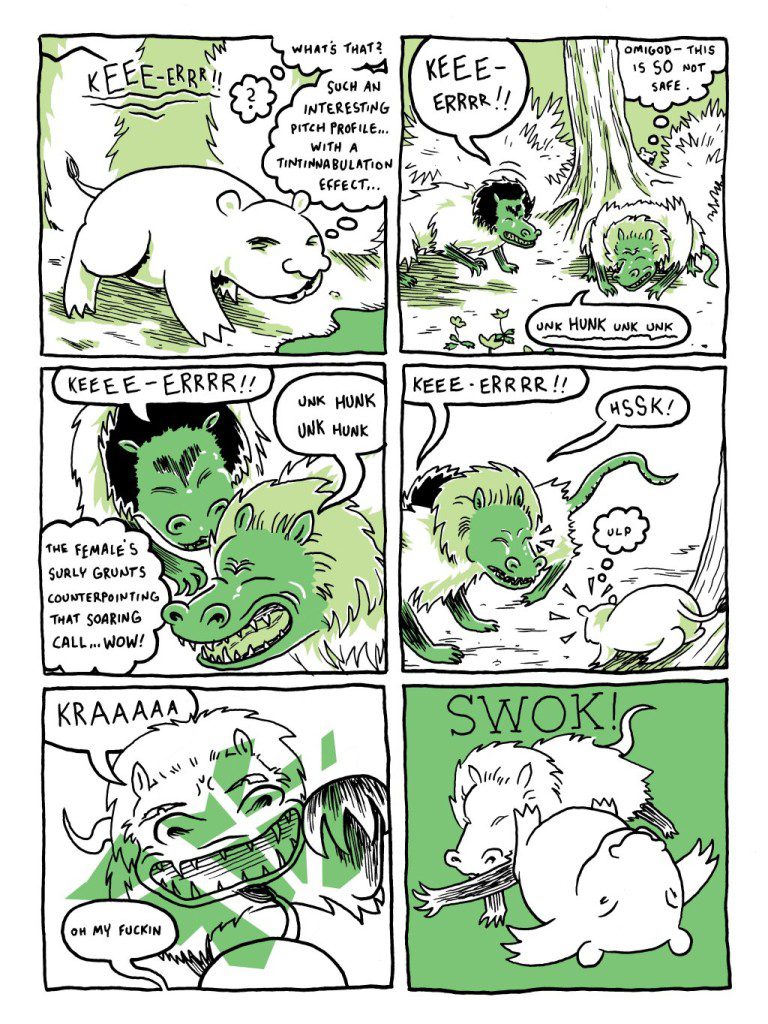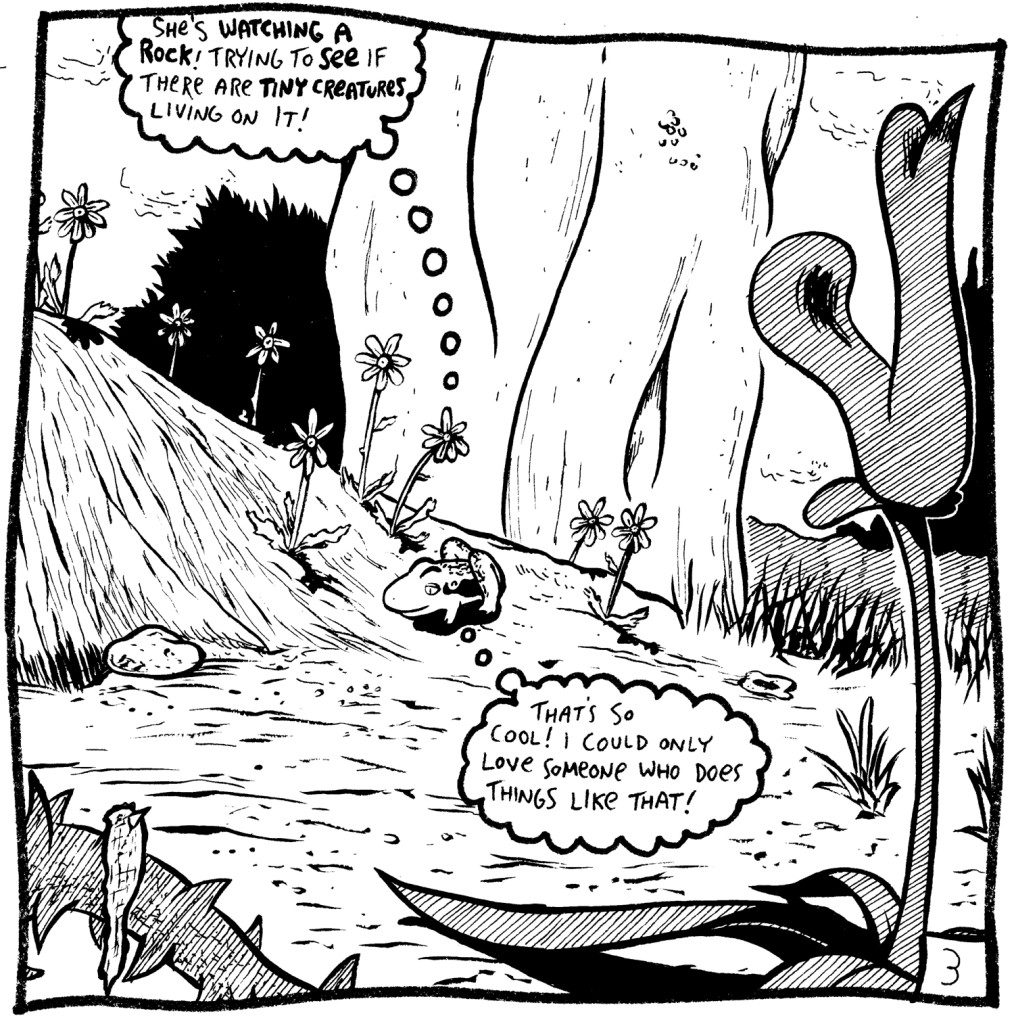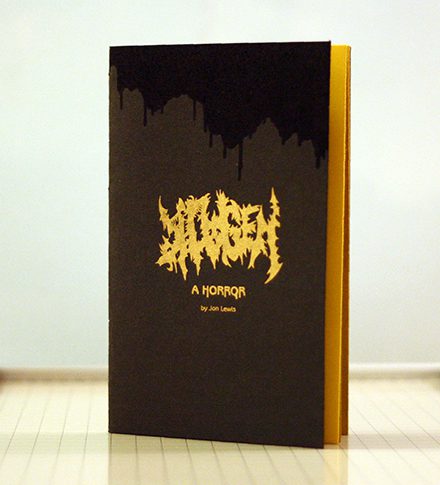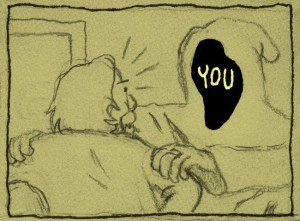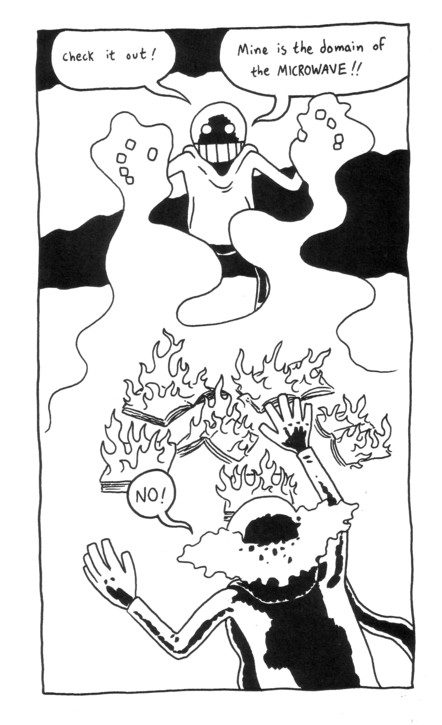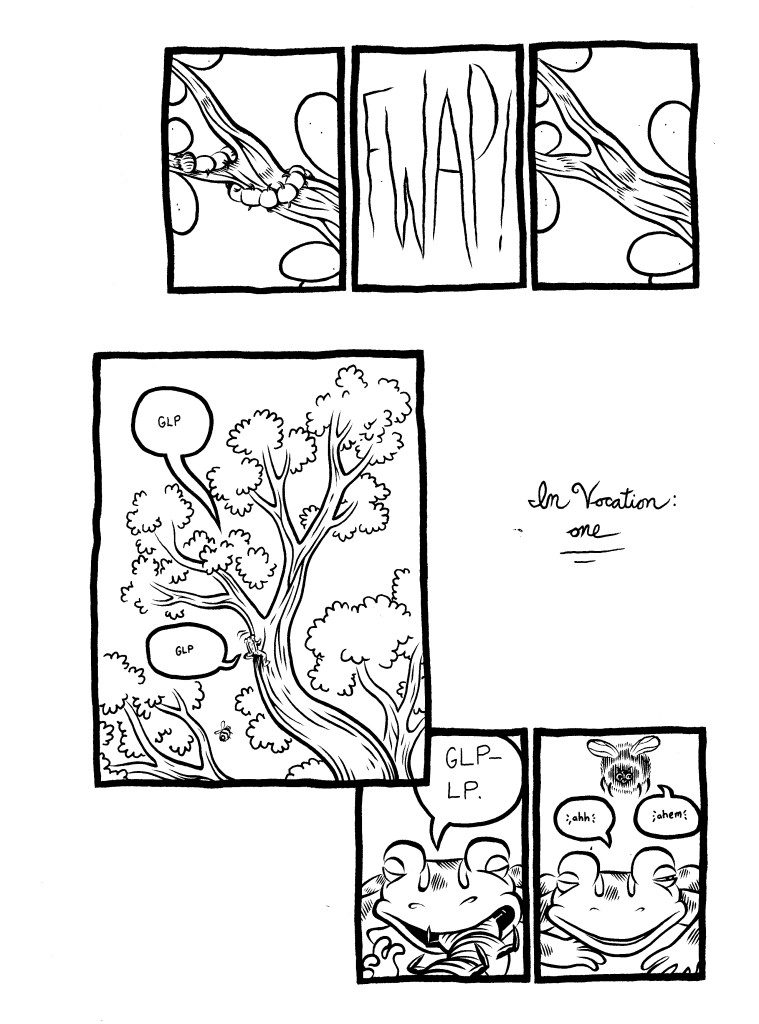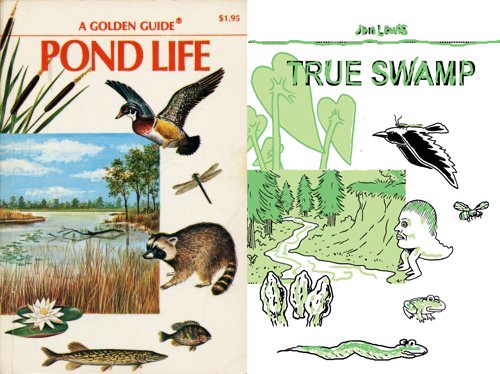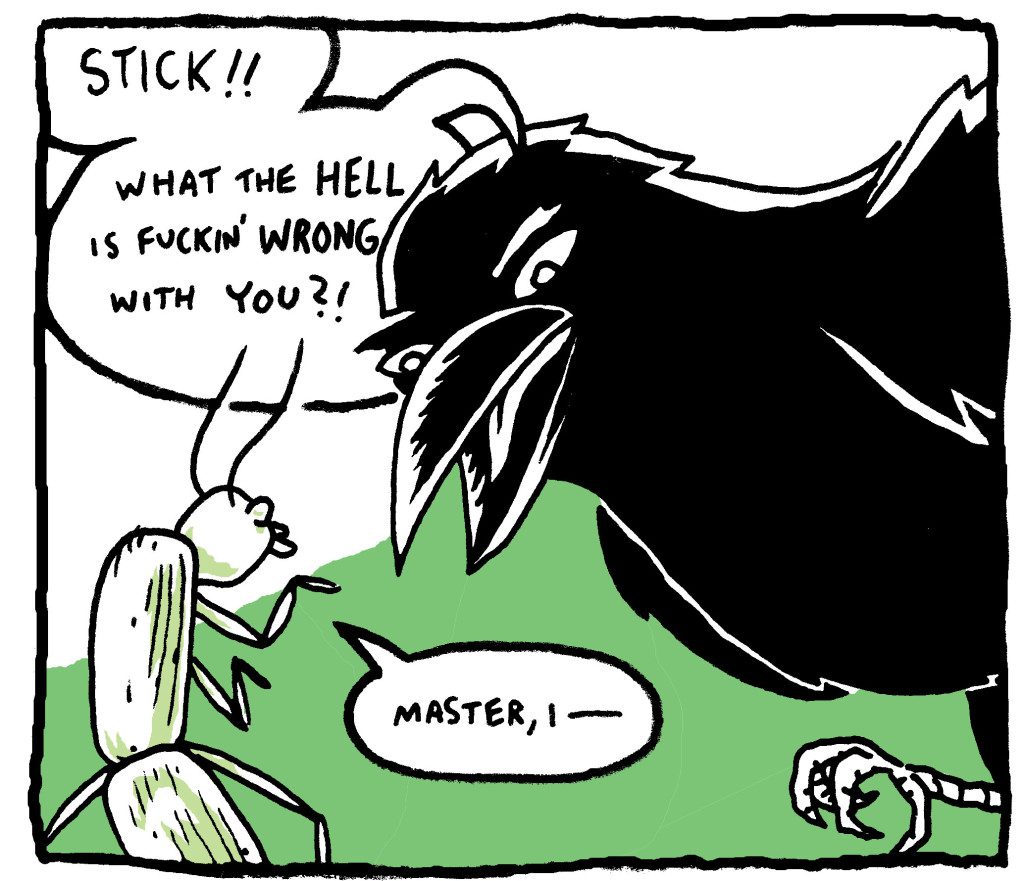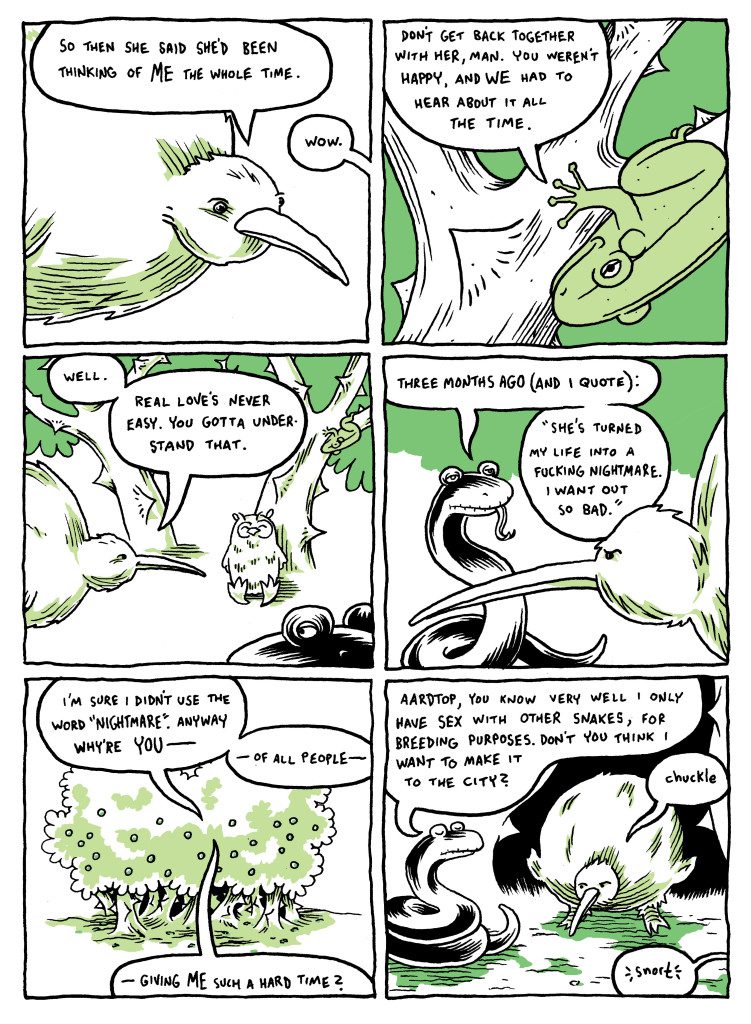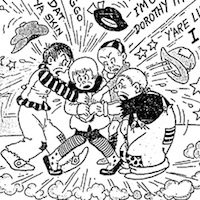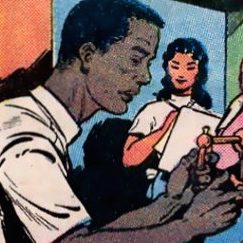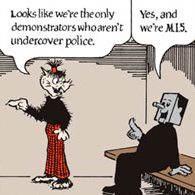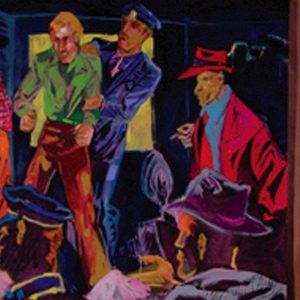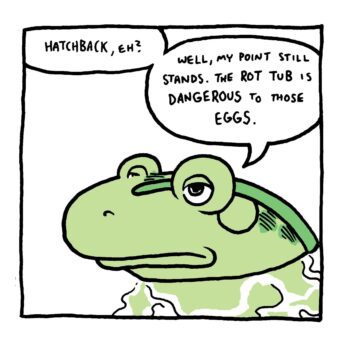
The New York Comics & Picture-Story Symposium is a weekly forum for discussing the tradition and future of text/image work. Open to the public, it meets Monday nights from 7 to 9 PM EST in New York City. Presentations vary weekly and include everything from historical topics and technical demonstrations to creators presenting their work. Check out upcoming meetings here.
This past week, I had the pleasure of talking with Jon Lewis, cartoonist and creator of True Swamp, about his life and work. First published in 1993, True Swamp is a beloved series set in a richly detailed swamp world and following the lives of its animal inhabitants. Winning a Xeric Award in 1993, it was later nominated for an Ignatz in 2001 and was also listed in Time.com’s “Ten Best Comics of the Year.” Uncivilized Books recently released True Swamp in a hardcover edition. Lewis also created Klagen: A Horror, Ghost Ship, Spectacles, and wrote DC’s Robin (#100-120). Lewis will be at the Brooklyn Book Festival on Sept. 22 and CAB on Nov. 9 with Uncivilized Books.
Andrea Tsurumi for The Rumpus: First off, what made you start making comics?
Jon Lewis: I started drawing stories when I was in first grade, and I’m not sure if I had started reading comics just yet. I feel like I started reading comics a year or so after that. They were picture book style: one big picture per page with a caption. It was about my dog fighting Snoopy. My mom had read me lots of Beatrix Potter when I was little and I was really into making little stories with my toys, so I had a narrative thing from right away, and of course, Beatrix [had those] talking animals.
Rumpus: What kinds of narratives appealed to you?
Lewis: Firstly, Beatrix Potter (especially The Tale of Jeremy Fisher, The Tale of Mrs. Tiggy Winkle, and The Pie & the Patty Pan), then The Wind in the Willows, Pooh, then superhero comics came and I sort of restarted comics-making about two years later. [They were] very combat oriented.
Rumpus: So you were making comics as a kid?
Lewis: Yes, like second grade. My best friend and I were drawing about the same world (a world of flying mice with handguns). There was a famous incident in second grade where someone did something bad and the teacher made everyone put their heads down on their desks “except Jon and Greg, you two can keep drawing.”
Rumpus: Were you continuously making comics up through high school and your illness, up until you started True Swamp?
Lewis: Not constantly. I didn’t draw comics in fourth through sixth grade, but drew them again in seventh and eighth grade, and then not again until I had to drop out of my senior year because of my illness. Almost none of those [comics] were panels gridded on a page. They were more like a bunch of text, a picture, a bunch more text. One of the few actual grid-style comics I did in middle school was one issue of Lenny The Frog and then I didn’t use him again until I was 21. Basically, somewhere in high school, I started reading Weirdo and I read Dale Luciano’s New Wave Comics survey when it came out in The Comics Journal, and those things gave me the sense that there was a whole world of bizarre little comics out there.
I was aware of the cassette underground from magazines I was reading, and I was making 4-track music, but somehow it took a few years before I realized I could do weird little comics and duplicate them. I did not realize until I was eighteen that you could photocopy on both sides of the paper. That was all that was holding me back. I thought you could only copy on one side and so you couldn’t make a proper booklet. When I realized Kinkos had double-sided [copying], I immediately started doing minis and sending them away to be listed in Factsheet Five and Comics FX and Small Press Comics Explosion. This was 1988 or ’89.
Rumpus: You were already going to comics events and being part of a comics community?
Lewis: Those comics were slavishly influenced by Jim Woodring’s magazine size Jim series, the Ed the Happy Clown stories and Rick Geary’s single-page work. After about a year, I went to a little convention in Minneapolis and met some of the older people in the Twin Cities scene. They were really nice to me and tolerant of me. Meanwhile, I had about a dozen other mini comics artists I would trade with through the mail. Since I was pretty sick, that was when I really internalized the fact that all that matters in life is books, music, comics and the mail.
I met Tom (Hart) then by trading minis with him.
Rumpus: How did True Swamp start?
Lewis: All the minis I did from about 1988 to 1991 were bitty things: lots of vignettes and weird one-pagers and stuff. Always very confrontationally surreal and puzzling. In the middle there, 1990, I moved to Seattle from St Paul. I was sick and had no job, but I was on SSI because of my illness and that enabled me to move. After a couple of years in Seattle, I had major surgery to remove most of my large intestine and that made me pretty close to healthy.
This gave me serious whiplash because I had habituated to this shut-in lifestyle and all of a sudden, those constraints weren’t there. So I had a really hard time knowing what to do and what to think for a while. I was suffering from a lot of depression and anxiety. I was trying to get a job, but couldn’t get hired. I was still on SSI. I thought, what if I tried to do one long story, focused and paced, so that I could really get lost in it and fend off my anxiety? So I thought, what do I like to draw? Swamps, wild-lands, ponds. I pulled Lenny the Frog out of my memory from that junior high comic and I thumbnailed a 24-page story. I had never thumbnailed or scripted in advance before.
Rumpus: What was it like creating the world for True Swamp? Did you have it in your head when you started?
Lewis: No. I just wanted to draw from the idea of a swamp, which I had always found comforting to imagine. When I was in my teens sometimes I would imagine my bed was a raft floating in a swamp. The details of that world kind of fell together in the telling. Once I put a few of the pieces together, I could see where it might go, but at the beginning it was intuitive, just pulling notions out of a hat. Like the cities thing which everyone likes.
Rumpus: You mean how the swamp characters use the names and images of human cities as currency?
Lewis: Yes, that might have come from reading Calvino or Jack Vance, not directly but it’s that kind of remapping of–I want to say vectors? Is that the right word?–onto unexpected objects in a way that feels right.
Rumpus: What draws you to worlds or characters that are animal-related? Or settings that are on the edge of conventional society?
Lewis: It has to be that grounding in the classic British pastoralist children’s stories [by] Beatrix and Kenneth Grahame, plus just loving to find little things under rocks and in the weeds at our cabin, plus the fact that I have always hated, hated, hated drawing rectilinear shapes. Stories about people have to involve buildings and cars and if I drew about animal characters, I could avoid all that.
And I just have always deeply connected to the idea of being a little creature hidden among the foliage. It’s just my damage. I guess that’s why I didn’t go the route of the Disneyesque-clothed-gentleman-animal. The less human the better. I probably sensed that doing animal characters without any physical human trappings would be more original and give me a hook.
Rumpus: Almost because your creatures aren’t those anthropomorphized versions—they seem way more real as characters. More human.
Lewis: Yes I think so. Because it’s their minds that matter, and the way they grapple with the constraints around them.
Rumpus: I love how your True Swamp cast are always dealing with 1) their animal identities and the peculiarities of their species and 2) their hobbies and interests. Like one is an inventor, you have a folklorist, a sound enthusiast, a wizard…
Lewis: Probably because of the circumstances of my having been a semi-invalid and also on government money back then and not having to work, there is this constant preoccupation with what things do with their EXTRA time. How do they organize themselves when they are at loose ends.
It’s probably the most blatantly anthropomorphic thing about the book because an actual animal tends to not have all this surplus time to dispose of. You pretty much look for food, fight, fuck and sleep to repair yourself, but I have all these creatures worrying about how to spend their time.
I invented the idea that Lenny’s species of frog has too many advantageous food-finding traits and is thus burdened with abnormal leisure. That’s covered in the stuff that will be collected in Vol. 2.
Rumpus: Ha! You’ve set up these side-interests as an interesting way to explore their characters. Their hobbies aren’t just, like, local color, they are activities that these creatures palpably love doing, even if it goes against their instincts. And they question that. There’s that lovely story about the lizard who’s dissatisfied with his life, sees fairies mating, protects their child, and finds meaning in the end.
Lewis: Yes, the whole idea that doing anything in an organized manner that isn’t directly involved with the natural history brief of your species is unwholesome. Hopefully, that brought me by an interesting side door into the idea of fundamentalisms, which is such a trite and sophomoric subject most of the time.
The Anole story was very strict about expressing these weird religious values without any irony. I was into these recorded folk legends from Scandinavia, which could be very blunt about things. So these religious animals have this tale about a morally disrespectable reptile who sees the light. That’s why the tale is said at the beginning to have been collected from a waterbird. It’s not a tale told by a reptile.
Rumpus: Is folklore a big influence on you? Did you grow up with it or seek it out?
Lewis: I didn’t get enthusiastic about folk material until I was in my twenties. This one particular book called Scandinavian Folk Belief and Legend started me off. It was the first thing I read where the sources were blunt and not dovetailed and not literary-ized. Just “my grandmother saw a troll cat. Here is what the witch said to animate it and then it flew across the meadow. The end.” Electrifying. Also about a year before I did True Swamp, I read The Silmarillion for the first time (having read The Lord of the Rings as a child and teen) and I saw how intense it could be if you simulated the mythical body of a world, which you had made up.
Rumpus: That would require a load of detail to make it really feel genuine. Or maybe just the right approach.
Lewis: Yeah it depends on what kind of cultural effusion you are trying to simulate. There’s these prose poems about the doings of gods and stuff, and there’s these police-blotter-like accounts of how your dad saw a ghost. I always figured the legends of animals would all be oral anyway. There’s the book of natural science that is the foundation of the mammals’ religion, but no one knows how to read or even see words, so their transmission of these strict rules is subject to this game of telephone, where what the human biologist told them has been distorted over hundreds of tellings.
Rumpus: Is that where the idea of certain animals acting as “books” came from?
Lewis: Yeah, if all recorded knowledge is oral, you need certain individuals to stay on top of very specific batches of knowledge and dedicate themselves to keeping it in memory. Also, it’s blatantly stolen from Bradbury. In the swamp, the animal is usually the author of its own “book,” so there is a strong element of self-aggrandizement to it; they aren’t just monks preserving words that have been passed down. It might be a kind of sublimated nest building or plumage. I always thought that’s what it is for people when they produce art.
Rumpus: Besides Bradbury, what science fiction has influenced you?
Lewis: Obviously, I am a world-builder by nature. Not to brag, but I did a great deal of dungeon-mastering when I was in grade school and junior high, and so much of that is the drafting up of your world and your parameters and the relationships of all your elements. I’m really more of a fantasy guy, though. In science fiction, you really have to take the rules of your world and work them out to the final degree, but I like leaving things smudgy and unsolved. I like making a kind of habitat for the characters and then letting things bounce about. A lot of my favorites are writers who used the trappings of science fiction but were really doing fantasy. Jack Vance again would be a prime example. I’m just not rigorous enough to do real sci-fi. In fact, there is very little accurate natural history in True Swamp, you’d get some terrible ideas about zoology from my comic. Gene Wolfe is another hero of mine, but he kind of sites himself on the exact cusp of science fiction and fantasy and fulfills the requirements of both. I read him as fantasy though, because he’s so much smarter than me. My favorite pure fantasist is probably James P. Blaylock who has written a bunch of books set in a contemporary vaguely magical and haunted Southern California. For pure sci-fi it has to be Samuel R. Delany.
When I read something like Kim Stanley Robinson, I almost have trouble enjoying it because I get this vertiginous sense of the insane amounts of RESEARCH he must have done. I admire that a lot but I’m way too weak.
Rumpus: Vast amounts of research are impressive, but can really get in the way of character building or storytelling. The smudginess is more accessible.
Lewis: I try to find a balance; there are a lot of things I know about the world of True Swamp but I have never allowed myself to make a map or to get too diagrammatical. It has to be a little dreamy.
Rumpus: Could you talk about Klagen: A Horror and where that idea came from?
Lewis: I love when a story or movie or piece of music gives off an intense sense of malice toward the reader. Terribilitas or dread. Like not just that horrible things are happening in the piece but that the piece itself has a gaze and is animated by malice and wants to leap its bounds and pierce the reader through the gut. Suspiria is a prime example of this. The film itself is evil. I’m really attracted to that feeling of being threatened in that way by art (I think there are probably people who aggressor-identify when they watch horror and people who victim-identify when they watch horror and I am definitely one of the latter.).
It is probably connected to my depression, which is basically a part of myself that wants me to die. These kinds of stories and music are magical spaces in which to safely enact that threat, maybe. It’s probably the same reason I have that instinctive fantasy of being a little creature hiding in a fern—a prey animal. But then I’ve had that fantasy since I was a little kid, when I had no depressivity, so if that connection is true the implications are kind of scary.
Anyway, short stories are the hardest thing for me to achieve. All my minis were that, but since True Swamp, since starting True Swamp saved my brain, I always go for these long serial things that are mostly middle where there’s plenty of space for me to hide. I have managed to trick myself into doing a few short pieces along the way, but even then it was almost always with the idea that they would be part of a conceptual set or cycle. The short pieces in Spectacles started out that way (the whole series was going to be nothing but exaggerated faux-autobio 4-pagers) and the piece I had in the SPX anthology was supposed to be part of a linked trilogy, and Klagen: A Horror was gonna be part of a three-story horror set. It doesn’t really matter cause all the things I just mentioned stand on their own and if I have to gull myself into thinking I’m starting something big in order to actually finish something small that’s fine.
So I like horror things that are really simple. Man goes insane, dies. Children turn evil, it sucks but we have to kill them. Monster is big, everybody run. I wanted to do something like that where there were no twists and turns to speak of, just a processional from A to B with one mood. There is a death cult and it will kill you, the end. I also wanted to try printing from darkened pencils without inking for the first time ever, like how Chester Brown did so much of his earlier work. Pencil for the line work with the only ink being the solid black areas. So I was scanning the pencils and I wanted to darken them then subtract the greys so they’d look like line work. And I put the slider all the way over, you know so that the lines darkened but all the white areas became overcast with an unbroken gray haze too. And it actually looked really cool to have there be no white areas at all. So that was the first happy accident.
The second happy accident was that I thought the word balloons didn’t really work the same way. The letters needed to be inked normally and the gray haze deleted within the word balloons. When I did that, the “white” in the word balloons popped like crazy. So I realized I could strategically take out the haze in a few places in the art too and they’d be weirdly highlighted.
And then the third “aha” thing was after I sent the pages to Tom K. to make an Uncivilized Books mini out of it, and he suggested using a yellow paper. That yellow acted as an undercoat so that wherever you had the gray haze, it was this queasy gray yellow, and wherever the art was “white” you had this glow-worm yellow.
Also, when I was in the middle of working on Klagen, I learned that one of my oldest friends had killed himself, someone who did more than any other person to keep me sane during the horrible period after I had to drop out of high school and before I moved to Seattle. He encouraged and appreciated my first mini comics in that time. He’d come hang out with me at my parents’ when I was sick and all my other friends were too busy busting out of teenhood to come over. So Klagen became melded to his suicide in my mind, to where I keep having to remind myself that I started it before he died and not after, that it wasn’t inspired by him. Actually Dylan Williams died that same week the following year so that week in September is starting to seem a little cursed to me. And while we’re talking for this interview, that’s actually next week so yeah.
I love that mini, it’s one of my favorite things I’ve ever done. It sold out from Uncivilized actually, and I just have like a dozen of them left. All the short self-contained pieces I have done are my favorite things of mine, actually. “Virtue and Virtuosity” in the SPX anthology, “Outside Inside” in Dark Horse Presents, the Anole story in True Swamp #5, the micro-stories in Local Stations, the 4 pager in Cartozia. I wish I could trick myself into the form more often.
Rumpus: How did Spectacles, Ghost Ship, and The Power of 6 get started?
Lewis: After True Swamp #5, I couldn’t figure out how to get to the next station of the story I had in mind for Lenny. The connective plot was eluding me. I had scrapped something like five different scripts. Finally I got so frustrated I cancelled the title. On a road trip to Vancouver with the other Seattle cartoonists I drew those pirate characters with their marionette physiognomies on a page in my sketchbook. I wanted to try a totally panel-less page concept where I would have to lead the eye around the page by other means, and I wanted to do something more drifting and polymorphous and strange. That was the germ of Ghost Ship. I was published by SLG at that time, and they were pretty bummed (and probably thought, rightly, that I was an idiot) that I was canceling True Swamp because sales were going up with every issue, but they were up for putting out Ghost Ship. Its sales were pallid next to True Swamp, and nothing I have ever put out in floppy booklet form has ever quite recaptured that sales momentum, by the way.
After I finished the first Ghost Ship story I realized the way out of the True Swamp conundrum which was blindingly obvious and I literally had never thought of this because of my problem with rigid thinking (which still plagues me). All I had to do was FLASH FORWARD A FEW FUCKING MONTHS. There didn’t need to be connective story. So I started doing more True Swamp stories at the same time as the pirate stories. And the new True Swamp stuff was laid out in a similar blown-apart structure to the grid-less pirate stuff. I really should have restarted True Swamp at that point! But I didn’t bring it back under that title until 2000.
I did three issues of Ghost Ship. There’s not quite enough pirate stuff to make a collection. It needs another 20 pages or so. Another age-old to-do. I like that stuff a lot; issue 2 in particular I’m really proud of. It’s weird that I did seafaring stories, however surreal, because I had and have absolutely none of Tony Millionaire’s actual love and talent for drawing ships. I’d rather draw a ship than a car but I don’t find it congenial and I’m not good at it. I guess the open sea idea appealed because it enabled a sense of unreality.
Spectacles started out with the idea of doing 4 page stories in the tone of EC Comics except depicting banal slice-of-life type events. Like if there was a black bar down one side of the cover that said REALISM! That concept lasted for those two shorts you can see in issue #1 of Spectacles, the one about the possum and the one about waking up too early. The series quickly turned into what Michel Vrana used to call a “sandbox title”, basically whatever short or medium or serialized things I felt like doing all thrown together. Everyone thought they should do this after Eightball, and almost everyone did. And almost everyone who wasn’t Dan met with crickets in response.
With my characteristic folly, I started like three different serialized items in the course of four issues none of which I finished. The Frost Changes was an interesting idea where I tried to use my enthusiasm for that Scandinavian folk material in a blunt shaggy dog this-then-that tone but transmuted into a suburban Minnesota milieu and with rough ‘folkish’ art. The problem is that that if you can’t actually draw well in the first place no one wants to see you intentionally drawing worse than that. I mean, when I draw my very best and slickest, people still describe it as “rough but acceptable.” I really want to try that story concept again at some point, I consider it a failure of execution. There was also a serial about urban wildlife, kind of the flip side of True Swamp, and I ran into interesting problems with that. It involved a lot of scenes of animal communities, where say you had five rats interacting all of whom were important characters, or a bunch of crows. How the hell do you make it so that flows for the reader without their having to stop every panel and look for the little earmark that tells them which rat is talking? It made me realize why animated films will have the skeletally skinny rat and the ridiculously rotund rat and the rat with a giant bushel of hair on his head. But that kind of solution wasn’t right for this story. It really wants to be prose, where you simply name the character. Not a comic. Maybe a slideshow with distinctive voices? I hope I live long enough to tackle that concept again because I really love it. I’ve started it in prose novel form something like five different times over the last decade. I love working in pure prose but it’s hard to push myself on that, knowing it’s a medium where I have no audience already built up. True Swamp is a science fantasy whereas that story is much closer to actual science fiction.
Spectacles was learning in public, for better or worse. Some cul-de-sacs, some paths that need exploring, a couple of gems.
Power of 6 comes from a feeling you and I have talked about when we were discussing Star Trek: The Next Generation and Deep Space Nine. When I was a kid, I used to read superhero team books, especially the Avengers which was my mainstay from about 1977 to 1980. And there’s shipboard sci-fi like those latter Star Trek series. And when I read or watch that stuff, I always just want it to be the in-between parts where the characters live together on this spaceship or in the Avengers Mansion and they’re hanging out talking or doing everyday shit. I lived in shared houses or shared apartments all through my twenties and that’s what the Enterprise or Avengers Mansion is to me. So I wanted to do a superhero team comic that felt like that, kind of cozy and talky and domestic. And man, I don’t even want to tell you how few people bought The Power of 6 Part One. It’s the worst selling comic I ever published by a long way. That’s the only time I’ve ever put something on hold because sales were so bad. But it’s only a two-part story and the second part is more than halfway penciled so I will definitely finish it at some point. For the handful of people who are waiting. That experience brought me up short though and made me ask what I should be spending my juice on and the answer was blisteringly obvious: True Swamp.
Rumpus: In 2012, Uncivilized Books released part of your True Swamp comics in a hardcover format. When is the second hardcover coming out? You mentioned the Sequential Artists Workshop had something to do with that recently.
Lewis: The second True Swamp hardcover collection is slated for Fall 2014 right now. It’s going to collect the material published by Alternative Comics in 2000 and 2001. I had a big hurdle to overcome for this collection, which was that I couldn’t find the original art. And I don’t even have that many boxes here to search. I thought the originals might still be in a couple of envelopes in Jeff Mason’s storage space in Gainesville. I kept trying to plan a weekend trip to Gainesville to search for it. I lived there from 1996 to 2002 and it’s kind of my favorite place I’ve lived. And Tom has his school up and running there now, which is just such a fabulous achievement and I haven’t been down to see that. Anyway, this year has been all money problems and health problems and that Gainesville dig kept getting put off. Finally I asked Tom [Hart] if he thought anyone in town would be willing to help and he had a couple of his SAW helpers go in Jeff’s storage unit and they found the packets within 2 hours and had scanned all 120-odd pages at super high res for me within a couple of days. So we’re all clear to go ahead with Volume 2, which collects all the True Swamp stuff with the crazy ungridded page layouts.
The existence of places like SAW and CCS is something that I wouldn’t have been willing to believe in 1993. It would have seemed like the Kubert School and the comics program at SVA would be the most comics-specific program you would ever see. When James started putting CCS together I thought he was crazy and hoped I was wrong and when Tom and Leela moved down to create SAW I thought he was crazy but suspected he’d prove me wrong. These schools are so amazing and the work being made by people who have come through them is already so amazing. Tom is such a born teacher. I wish I had that gene. Comics are a gut-eruption for me, when I lift the hood on it, I just don’t know what to say about what’s under there. When I’ve substitute-taught I’ve been totally dumbfounded.
Rumpus: I wanted to ask you about how many of your stories center around ensembles and not typical one-hero story lines.
Lewis: Yeah, so I feel like there has been a definite progression over the course of True Swamp like a pull-back shot: in the first series, it was tight on Lenny, and in the second series, it had a few protagonists, and now in the third series, it’s as much of a panorama as possible. Maybe too much so; I hope not. I guess it is part of the world-building gene: wanting to have different angles and approaches on this habitat you’re building.
Also when I was younger, of course, I was bringing out all these eruptive feelings in Lenny who was very close to myself, whereas when I got older, I became more interested in a kind of character polyphony and wanting to write characters who were not like me at all.
Rumpus: Do you pull from real people or real experiences?
Lewis: Real people for sure. I definitely blend people I’ve known into the characters. Friends and not-friends alike. I haven’t done too much of importing my own experiences into my work, partly because I have barely had any experiences of any kind. Partly because I like to take the emotional color of this memory or that and evoke it with a totally invented scenario. I dunno, I have never kept a diary or journal and never did any autobiographical material, even though I love autobiographical comics a lot and read them like candy. I have a terrible memory for specific details of my own past, really terrible. I just remember the feelings and atmosphere of the situations but not what people said or did. Same with novels I’ve read, movies I’ve seen. I just recall them as these swatches of color and abstracted feeling. Rereading things is really great for me because of that.
Rumpus: Yet your dialogue feels really natural. Do you have a way of imagining how these characters speak?
Lewis: I don’t know. In the beginning I guess it was just how my friends and I talked, with the swearing amped up. I was really in love with swearing partly because I was in the first flush of getting into Mamet. Retailers used to get mad at me because of the torrents of profanity. I feel like I have never been deliberate about styling dialogue for certain characters. They just have their voices. I know that sounds simplistic.
Rumpus: Do you have certain things you’re looking forward to exploring with True Swamp?
Lewis: I do. I do not keep a tightly blocked out plot outline but I have a clutch of notes that are basically stations the story is going to hit, and I pretty much know how it all gets there but I leave it loose enough to allow an alternate route to surprise me on the way. That’s especially important with all the counterpoint I have now. Things can really change based on how these threads hit each other. And there are notes that I am really looking forward to getting to, but they are probably years away at my pace. As my rate of drawing has gotten less I have made the stories more concise to make up for it, but it always feels too slow when you’re the one drawing it.
Rumpus: You had started discussing your recent arm injury and how you’re going to have to retrain yourself to draw. How do you think this will impact your work?
Lewis: It’s really been a hard thing. I’m kind of in the pits about it right now. I had frittered away a lot of time this spring and was ramping up to get productive again with a couple of short pieces for anthologies edited by friends of mine. A four pager for Isaac Cates’ YA shared-map Cartozia Tales [anthology] series and a two pager for a hybrid literary/graphic anthology, which I think has not been officially announced yet. So my way with the 45 hour a week day job thing is to not really try to do much creativity during the weeknights (because I come home too destroyed), but to blast a ton of work into the weekend. So I wrote and thumbnailed my Cartozia story one weekend, penciled it the next, and inked it the next. With constant typing and mousing at my day job during the intervening weekdays.
And then the next weekend, I did the pencils for my story for the other book. And then in the middle of that week, my right hand got all cold and numb and I got this bruise-like darkness at the base of one finger. I thought I was having a blood clot or something but the walk-in place said it wasn’t, rather some kind of repetitive stress injury. So I did what a lot of people do and switched my mouse to the left side and just used my right to type a little. But it got worse fast with pain and coldness along my forearm down through my hand. So I stopped typing or writing or drawing with the right at all. And it remained really reactive after a week of rest. I got in to see a specialist and it was Cubital Tunnel Syndrome, which is the 2nd most common repetitive stress injury after Carpal. Where carpal happens where your nerve travels through your wrist, this happens where your nerve goes through your elbow. The ulnar nerve gets compressed at the elbow and you get the manifestations downstream in your hand and forearm. Basically you have to stop doing things that involve bending your arm.
Rumpus: Once it heals, will you have to worry about it returning?
Lewis: I think so. During this healing phase, you have to keep your elbow in the range from straight (0 degrees) to a max of 45 degrees, anything sharper than that and you prolong the injury. Putting food in your mouth, brushing your teeth, drawing if your drawing posture is anything like mine. I have always drawn on a flat desktop or even on my lap, with my face right over the page, and my arm motion super uptight with all the action coming from the hand and wrist. I’ve never used an angled table. I’ve always drawn small and tight and up close to my eyes.
Rumpus: Will your method or your pace have to change?
Lewis: I don’t know. I had some crazy electrical shock tests a couple of weeks ago on my arm, and they found that the damage is not bad enough to warrant surgery, but it is a slow heal and I may have to restrain my arm motion for another two months or so. And it’s already been almost three months of this. I figure when it does heal, I’m gonna have to revamp my physical approach if I don’t want to end up back here again. It’s intimidating, but exciting too. My page is gonna have to be like 24 inches from my eyes if my arm’s in that position. The art is gonna have to be large and it’s gonna have to be arm-driven and I don’t know what that’s gonna mean. It’s weird timing though because I’m not at a specific point in True Swamp where a notable change in style is warranted. It would be convenient if this had happened at some big crossroads in the story.
I’m not sure if I should MAKE the story jibe with the change or just proceed with where it was already headed. Constraints are awesome but midstream is weird.
For now, it looks like my story in Cartozia #1 will be the last piece in my old style. I had already penciled a bunch of True Swamp pages during the spring, but hadn’t inked them yet.
I really want to play my fucking guitar again too. I even miss doing dishes.
Rumpus: Speaking of guitar, it sounds like music is something that’s central to your interests. What place does it have in your life and work? And what is it about soundtracks that you like?
Lewis: I live on music. Seriously, the thing I most look forward to about the day when I wake up in the morning is hearing more music. It’s my meat and drink.
I got into film scores by way of classical music, which was my main preoccupation from about 1996 to 2007. And in the last six years, film scores have become a major obsession of mine. I like that they use the toolbox of classical composition for different aims. I like that they are meant to be complementary; not meant to be a complete experience in themselves. That incompletion is stimulating to me. Like I said, I am very keyed to the color and feel and atmosphere of experiences more than the specifics and film music is like a story without all the annoying details and tawdry plot business. And I like that these composers do their work in the shadows and are prolific in a way that composers of the Baroque were. They are not allowed to get hung up in the auteur theory or aspire to masterworks. It’s all messy and contingent and I love that.
I love prolific creators in general: Jack Vance, Liszt, Kirby. Ironic, given the trickle I maintain of my own work.
Rumpus: How was Kirby an influence on your work?
Lewis: When I was a kid, I hated Kirby. I liked the fussy pen-based artists who were current at that time like John Byrne and George Perez and Brian Bolland. That was proper art. Kirby just looked wrong. Around when I was twenty, I had a total about-face with Kirby and became utterly drunk on him. Tom [Hart] did too at the same time. Those Byrne and Perez types are prawns next to him. So yeah, he became a big influence, especially the way he used blacks and the way he arranged foregrounds, midgrounds, and backgrounds against each other. His way of world building like in the New Gods is just right to me. The ideas are freshly hewn out of the sky, the edges haven’t been polished off to join neatly with the adjoining ideas. What superhero comics became in the wake of the Handbook of the Marvel Universe is so abhorrent to me. Kirby never hesitated to just make up something completely new instead of reaching for some existing character from 30 issues ago. Always invent.
I should say that I also think Gene Colan was a giant in the seventies as well. One of the only ones who had his own thing that was totally apart from Kirby. I hate all that Neal Adams stuff and his ilk. That was the beginning of the end. Using photo reference for everything. Just make up a goddamn radio out of your head! You’re afraid some twelve year old is gonna make fun of you because you don’t know how to draw a radio?
Rumpus: What was the comics scene in Seattle like when you were there? From your perspective, do you see a change in how comics communities function or exist now?
Lewis: It’s hard to compare because how much of the difference is 1993 vs. 2003, how much is Seattle vs. New York City, how much is comic books vs. graphic novels, and how much is just me at 43 vs. me at 23? Today is a better time to be young and doing comics in so many ways; the festivals are better, the publications look amazing, the scene is collectively over most of its hang-ups, there’s perceptive critical work all over. I’m truly jealous of your generation. The comics-only schools and the shift to squarebound book format must be the biggest differences.
At the same time, when my friends and I started putting stuff out it was conceivable that you could end up making a living from putting out comics regularly. Not that many people did, but it could be done. I feel like you can’t do that anymore. You have to count on your comics work bringing you opportunities for things that actually do pay like illustration, animation or teaching. I mean, the books look great and have great distribution and people do get advances for them. But I don’t feel like people get to do their comics as their primary thing and that’s disheartening. Also, a lot of the great cartoonists who were putting out work every few months when I was in my twenties are now putting out something every few years if you’re lucky. I miss that. Obviously I’m no different, with my day job and my health coverage and my fucked-up arm. It’s the best time to do art but a shit time to make a living at art. I just… I miss the time of cartoonists being prolific and myself being prolific. I mean, a lot of people are still willing to spend serious cash on printed comics, which speaks to the allure this medium can cast. You can’t say the same of music in its physical format. We’ll see.
*** Image Credits:
Image 1: Photo of Jon Lewis and Bucket, 2013
Image 2: Jon Lewis, Cover, True Swamp: Choose Your Poison, Uncivilized Books, 2012
Image 3: Jon Lewis, True Swamp: Vol. 3, page 29
Image 4: Jon Lewis, panel, True Swamp: Vol. 1 Issue 1
Image 5: Jon Lewis, True Swamp: Vol.3, page 32
Image 6: Jon Lewis, panel, True Swamp: Vol.1 Issue 4
Image 7: Photo of Jon Lewis’s Klagen: A Horror, Uncivilized Books
Image 8: Jon Lewis, panel, Klagen: A Horror, 2010
Image 9: Jon Lewis, panel, The Power of 6: The Twisted Apples, 2006
Image 10: Jon Lewis, True Swamp: Vol. 2
Image 11: Jon Lewis, mock-up cover for the first True Swamp mini comic with Uncivilized Books, emulating the classic Pond Life cover.
Image 12: Sally D. Kaicher & Tom Dolan (illustrators), cover, The Golden Guide: Pond Life, 1967
Image 13: Jon Lewis, panel, True Swamp: Vol. 3
Image 14: Jon Lewis, panel, Cartozia Vol. 1
Image 15: Jon Lewis, True Swamp: Vol.3, page 45
***
About the author: Andrea Tsurumi is an illustrator and cartoonist who likes her robots sad and her history funny. You can see her work here and check out her latest projects here. She lives in Queens, NY with Alexander Rothman.

